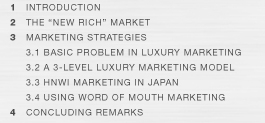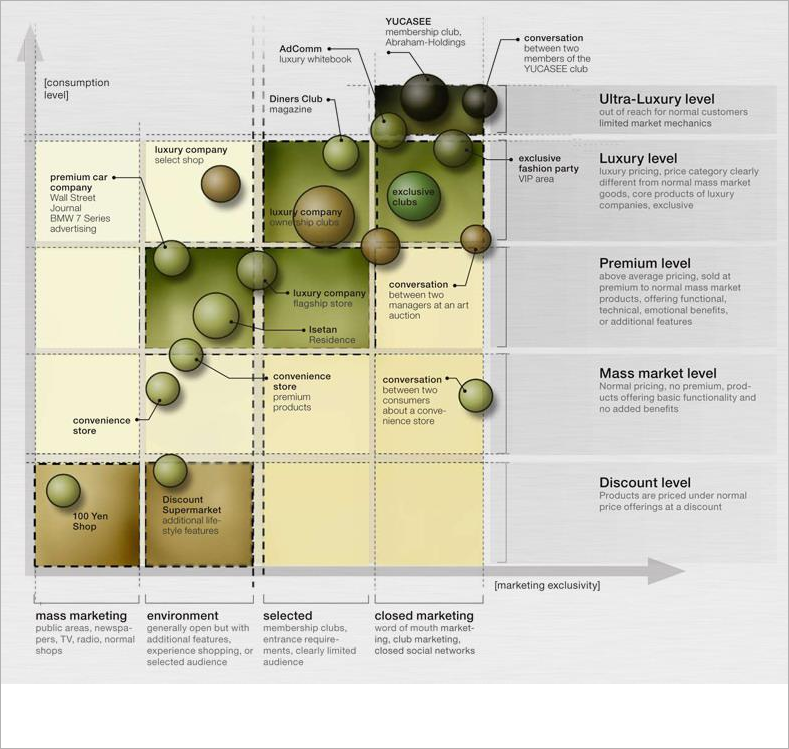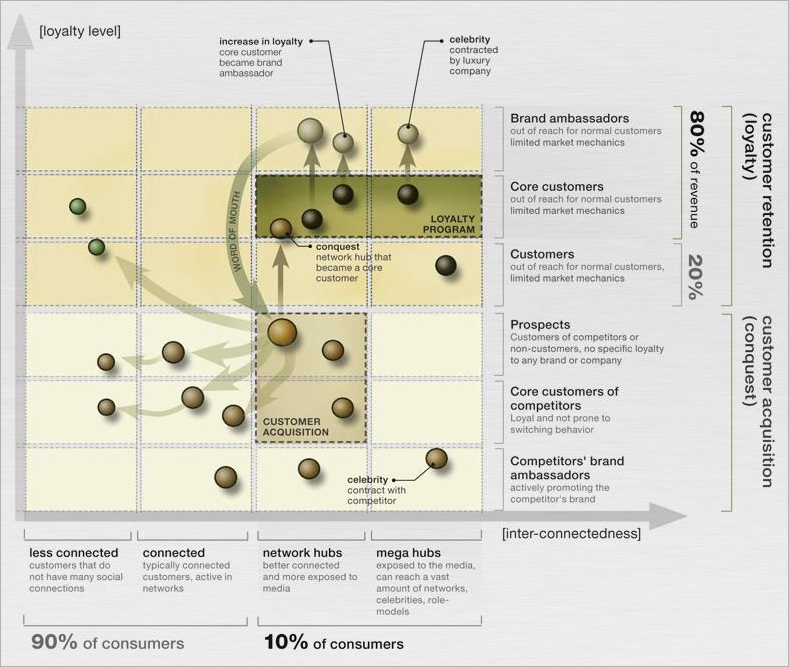can occur (Katz and Lazarsfeld 1955). Opinion leaders process the information
first, since they tend to be more frequently exposed to mass media (figure 3.2)
(Richins and Root-Shaffer 1988).
The problem about changed consumer attitudes from a marketing perspective is the
higher immunity of the discerning and highly sophisticated opinion leaders
against traditional marketing channels and mass media. Especially HNWIs do not
want to be targeted by direct push-approaches (figure 3.2) (Push marketing is
the traditional direct type of marketing. It includes direct mail, advertising,
cold calling, and other techniques that push your products and services). To
get access to rich customers in general, and specifically their opinion
leaders, different channels have to be employed. This is done with
pull-approaches (Pull
marketing brings customers to you by their own incentive. It is a more indirect
approach that includes using proactive referral systems, speaking, writing,
having a visible presence within communities and social networks, and providing
additional information once the potential customers have given their permission
to do so). Once a relationship based on trust is established, customers can be
more receptive for direct push-approaches. A company's own customers can
therefore be targeted more directly than new customers, leading to two
different models of luxury marketing—customer acquisition and customer retention.

One general characteristic of the way consumers are building preferences and
choices was named the “law of the few,” meaning the opinions of 10% of a consumer market is influencing the buying
behavior of the other 90% (Lazarsfeld 1944). The marketing model (figure 3.1)
in which a company employs the services of an advertising agency to create
media that will influence the audience directly, is in truth a simplification.
The “two-step flow theory” states that instead of having a direct effect, advertising messages are
channelled through opinion leaders with influence in social networks, and that
it is through their output word of mouth that communication effects
Customer acquisition
Acquiring customers for luxury brands must be differentiated by wealth level and
the customer's marketing exclusivity, meaning the inclination of a consumer to
be not receptive for mass marketing environments and mass media. The theory is
that the higher the wealth level, the less receptive the customer is to normal
marketing channels (Abraham-Holdings 2008A, Tsuchiya 2007: 76-77). Figure 3.3.
shows marketing environments in a combination of the consumption level marketed
in, and the media-channels used to transfer the message, the marketing
exclusivity (It is important not to mistake consumption level with consumer
level. The consumption level [figure 3.3] defines the relative price level of a
product sold, advertised or otherwise marketed, while the consumer level [from
figure 2.1 and table 3.1] defines the level of a
consumer's social lifestyle and connections). Everything can be considered a
marketing environment: the lobby of an expensive hotel, a private party, even a
talk among friends can be the scene of a conversation about a product or
service, or a setting for brand exposure and image building.
A change in marketing environment and consumer behavior has led to a gradual
decline in the traditional mass market, with the so called “death in the middle” by companies who failed to differentiate themselves either by price (offering
qualitative products in the discount market) or quality and emotional appeal
(offering new luxury products and premium offerings, or changing the shopping
environment). What has happened in the last decades is a gradual shift in
marketing exclusivity from the left of figure 3.3 to the right.
Consumers either demand more of their shopping experience or look out for the
lowest price or convenience (Silverstein and Fiske 2005; Nunes et al. 2004;
Danziger 2005; Anterior Insight 2008).
The higher the wealth level, the higher is the average marketing exclusivity of
the marketing environment and the media necessary to gain access to the
individual customer. Thorough customer segmentation can reveal at which media
level the marketing has to be executed. As most brands have a product range
which spans some or all of the consumption levels from figure 3.3, an holistic approach can be necessary. The problem in luxury marketing is how
to reach the higher levels of marketing exclusivity, as these tend to vary
depending on cultural context, are linked to specific networks, and are not
directly accessible.
Consumption level. An abstract concept that classifies the products sold, advertised or otherwise
marketed. It can be roughly classified as: 1) discount level—products that are priced below normal price offerings; 2) mass market level—normal pricing; 3) premium market level: above average pricing, products with
additional features or an emotional component; 4) luxury market level—luxury pricing with mark-ups of over 30% to normal mass-products, and products
in higher price categories that include many of the most prominent articles of
famous luxury brands (hand-bags, premium cars, watches); 5) ultra-HNWI level—luxury articles that can be generally considered out of reach for normal
consumers, including ultra expensive sports-cars, yachts, private jets, and
luxury condominiums. The higher the consumption level, the higher the tendency
for a negation of market mechanisms.
Media exclusivity. 1) The first quadrant is open mass media, TV and radio, newspapers and widely
distributed magazines. 2) The second quadrant symbolizes shopping environments
that are open to the general public but distinguish themselves by experience
shopping or other features (such as convenience). This would include any shop
that offers its customers added value by making the shopping experience
extraordinary, and magazines that target very specific audiences and limit
their distribution to certain outlets. 3) The third quadrant is the beginning
of closed marketing environments, being generally open to everyone who is able
to meet the entrance requirements—a membership fee (membership clubs), the purchasing of a certain product
(ownership clubs), or other conditions (like a certain mileage that gives
access to airline lounges, or a golden credit card). The conditions have to
limit the audience without making it impossible to meet the conditions. Often
these environments come along with a specific customer segmentation (income,
age group, interest). 4) The fourth quadrant represents closed marketing
environments. Either the entry conditions can only be met by a very limited
number of people (American Express Centurion Card, the YUCASEE membership club
in Japan—which is only open to people with more than 100 million yen in assets—ownership clubs of ultra-HNWI products, the Roppongi Hills Club), or are not in
control of the customer at all (selection under non-disclosed conditions,
exclusive membership clubs, private parties, personal invitation). At this
level of marketing exclusivity the used media is usually word of mouth,
personal contact, patronage of events, or selectively distributed information
material (magazines, direct-mail).

Customer retention
The basic approach for customer retention is illustrated by Tsuchiya (2007), who
makes three propositions: Proposition 1: 80% of the revenue is delivered by 20%
of the customers of a luxury company. Proposition 2: Only about 10% of the
customers are opinion leaders, while the other 90% tend to be heavily
influenced by them in their buying decisions. Proposition 3: Customer
acquisition is 10 times more costly than customer retention (Tsuchiya 2007:
40-41, 7-71).
Considering propositions 1 and 3, it makes sense to treat some customers better
than others and to invest more energy into retaining their loyalty (Nunes et
al. 2004: 57, Tsuchiya 2005, 40-41, 70-
73). The challenge is now how to move the 10% opinion leaders of your 20% best
customers up the loyalty ladder in order to become brand advocates, so that
they can be effectively used for word of mouth marketing strategies, as can be
seen in figure 3.4. To do this, special services are created for those 20% top customers in order
to move them up the loyalty ladder, giving them status and incentives to talk
about their positive experiences to others. This approach is already practiced
in many industries: by airlines (mileage clubs), by credit card companies
(fringe benefits and concierge services) and financial services providers
(special treatment and privileges, private wealth management) (Nunes et al.
2004: 67).
As loyalty tends to increase only with extreme customer satisfaction, what is
needed is outstanding performance and services (Hongoard 2002: 248).
Relationship economies are strongest at the higher consumption levels, as
market mechanisms are modified and eliminated at the top, where switching costs
are caused by social factors like emotional attachment to products and
conformity within social networks. In contrast, in the highly competitive
middle-class environment the idea of extreme customer satisfaction is out of
place due to low switching costs.

Loyalty program. Special services are executed for the top 20% of customers, selected by CRV
(customer referral value). The special treatment triggers a word of mouth
mechanism. Instead of targeting the majority of customers with push-approaches
(advertising) the 20% opinion leaders of the core customers are treated with
pull-approaches.
Word of mouth mechanism. Due to a loyalty program, core customer A's loyalty is increased to ambassador
level. He now has an incentive to talk about his experiences. Network hub
prospect B can not be reached by normal media channels. In a conversation with
the very satisfied customer A, network hub B is convinced to try the product of
the luxury company, anticipating the same preferred treatment that customer A
was talking about. He now has an incentive to increase his spending in order to
become a core customer. Because of his position as a network hub, he dispenses
the information about his switch to many other people. Therefore, a customer
retention program becomes directly connected to the customer acquisition
process by turning loyal customers into brand ambassadors. Without word of
mouth, network hub B would not have been receptive for a direct marketing
approach.


